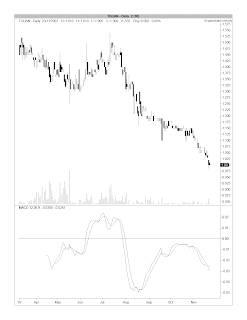Today, we have the listing of 4 CWs from CIMB, i.e. Toyota-C1, Bursa-CH, TM-CG and CCCC-C5. I do not intend to cover the CWs of Bursa-listed companies nor the Hong Kong-listed CCCC, for now. I will instead look at Toyota-C1 only. The main terms are highlighted below.

Based on the morning closing price of this CW at RM0.47 & the Toyota Motor Corp (Stock Code:
7203) as at 14.27 Tokyo time of Y6080, this CW was trading at a premium of 12.64%. At this premium, the CW is not cheap but not at sky-high premium that we have witnessed earlier. Looking at the chart of this stock & its key statistics, a case can be made for buying Toyota at the present price as well as buying the new Toyota-C1.
Toyota is probably the world's largest auto maker (for more details from Wikipedia, go
here). Its shares are traded in Tokyo Stock Exchange ('TSE') as well as on other exchanges such London Stock Exchange ('LSE') & New York Stock Exchange ('NYSE'). For the purpose of valuing of Toyota-C1, the share price as traded in TSE will be used (see Chart 1).
 Chart 1: Toyota's monthly chart as at November 26 (courtesy of TSE)
Chart 1: Toyota's monthly chart as at November 26 (courtesy of TSE)From Chart 1, we can see that Toyota share price has been correcting for the past 1 year. On November 22, the share price hit a low of Y5750 before rebounding. On further weakness, the share price may find support at the tentative uptrend line support of Y5500 or the horizontal support at Y5400. However, you can see that the faster 5-mth MA is poised to cut below the 25-mth MA, which will be a bearish sign. A strong rebound is needed to negate this negative sign.
To get a second look at Toyota's share price, I have appended the price chart of its trading in USD on the NYSE (see Chart 2 below).
 Chart 2: Toyota's daily chart as at November 26 (courtesy of Yahoo Finance)
Chart 2: Toyota's daily chart as at November 26 (courtesy of Yahoo Finance)This chart also shows that the stock is near its tentative uptrend line support at USD105/6 or its horizontal support of USD108/9. Like the earlier chart, we can see that the faster 200-d MA is also poised to cut below the slower 300-d MA. Again, a strong rebound is needed to negate this bearish sign.
Based on
Key Statistics provided by Yahoo Finance ( an extract provided below), we can see that Toyota is trading at attractive multiple of about 10 times its earning.

Based on fairly attractive valuation & a potential rebound in the price of Toyota share, the Toyota-C1 could well-surprise many to the upside. A slow entry over the next one or two weeks' time might be a safer option as one would be able to see whether the Toyota share price would cease to threaten its uptrend line as well as seeing the end of the initial market-making activities that tend to hold the CW at an artificially high price. If the share price does not break any of the above-mentioned uptrend line, a good entry to Toyota-C1 would be around the RM0.40 level (paying a premium of 10%).

















































